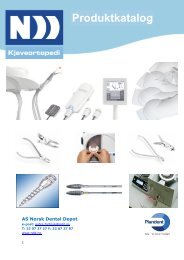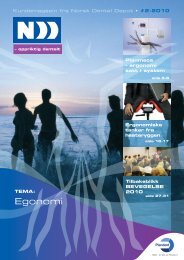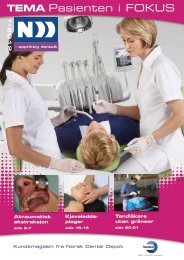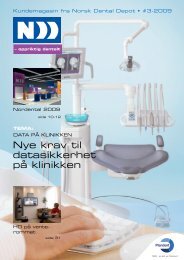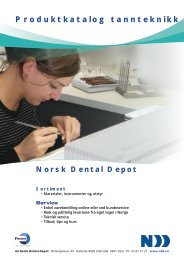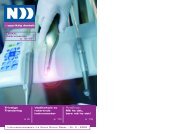Biodentine
Biodentine
Biodentine
You also want an ePaper? Increase the reach of your titles
YUMPU automatically turns print PDFs into web optimized ePapers that Google loves.
10<br />
2.2 - Density and Porosity<br />
The mechanical resistance of calcium silicate based materials is also dependant on their<br />
low level of porosity. The lower the porosity, the higher the mechanical strength. The<br />
superior mechanical properties of <strong>Biodentine</strong> were determined by the low water<br />
content in the mixing stage. Two different methods confirmed the low porosity of<br />
<strong>Biodentine</strong>.<br />
First a mercury intrusion porosimetry method was used. Mercury, the only known liquid<br />
really suitable for porosimetry type measurements, can be forced into pores. The<br />
pressure required to intrude mercury into a pore is determined by the pore diameter. The<br />
samples were prepared under the same conditions as those used for CS measurements.<br />
Measurements were carried out on fourteen 28-day-old cylinders, dried at 40°C in a<br />
primary vacuum for 12 days to eliminate residual water. The porous volume and the<br />
distribution of pore diameters were determined by mercury intrusion porosimetry<br />
(Autopore III, Micromeritics Instruments Corporation, Norcross, USA).<br />
Material Porous characteristics<br />
Dens. g/cm3 Pore V.cm3/g Porosity %<br />
PMTA 1.882(0.002) 0.120(0.002) 22.6 (0.2)<br />
FUJI IX 2.320(0,002) 0.033(0.002) 7.2 (0.2)<br />
BIODENTINE 2.260(0.002) 0.031(0.002) 6.8 (0.2)<br />
As expected, <strong>Biodentine</strong> exhibits lower porosity than ProRoot ® MTA. The density and<br />
the porosity of <strong>Biodentine</strong> and Fuji IX are equivalent.<br />
Electrical Resistance Measurements<br />
An alternative method to illustrate the hardening process is to examine the mobility of<br />
ions which depend of the pore size and number of pores during setting by<br />
electrochemical analysis. Impedance spectroscopy technique leads to the increase of<br />
the electrical resistance along with the porosity reduction (Fig.2) (Golberg et al., 2009).<br />
Fig. 2: Electrical resistance (Ω) versus time (hours)<br />
during setting of <strong>Biodentine</strong><br />
This shows that even<br />
after the initial setting of<br />
<strong>Biodentine</strong>, the<br />
material continues to<br />
improve in terms of<br />
internal structure towards<br />
a more dense material,<br />
with a decrease in<br />
porosity.<br />
<strong>Biodentine</strong> is an<br />
evolutive material which<br />
improves its mechanical<br />
properties with time.



